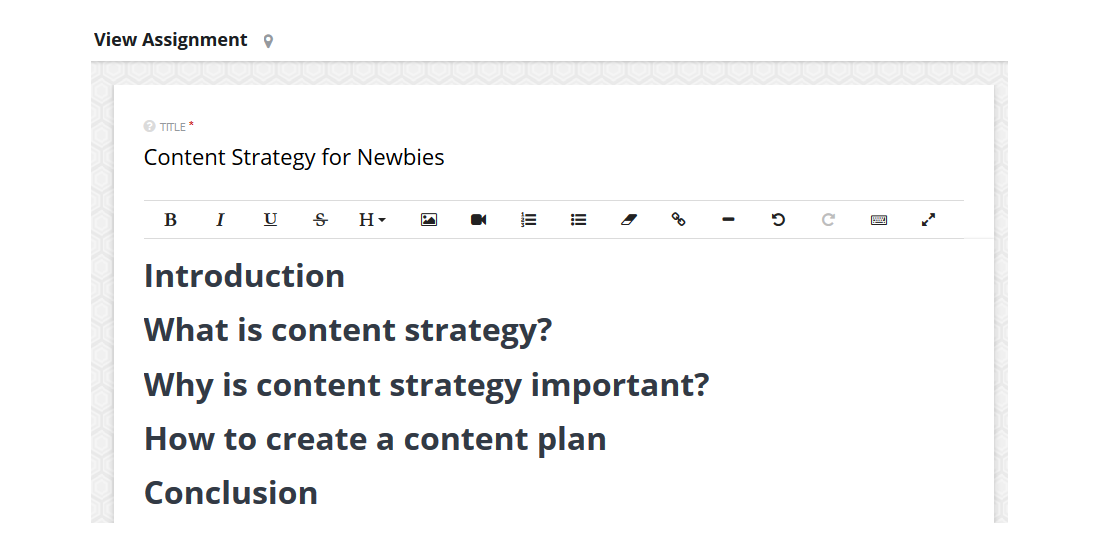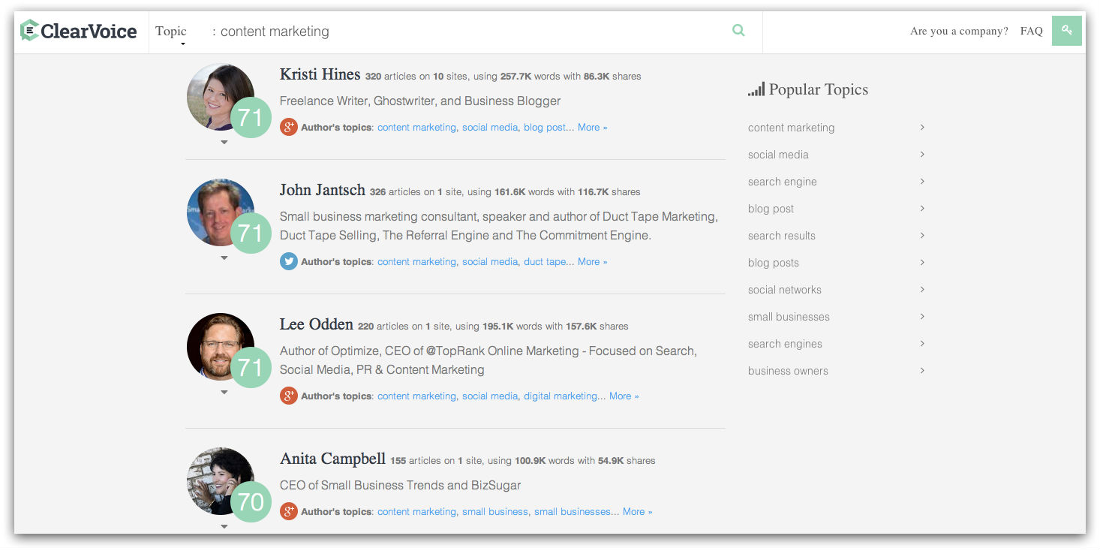The problem with startups and blog posts is:
Although the business owner may understand that content gets more traffic, it is not the norm for them to understand what’s necessary to produce content that gets more traffic.
And so, to save costs, they write the content themselves, and because (how to say this without giving offence?) they don’t know what they’re doing, what they produce is not worth much. That’s that problem.
The other common problem with startups, is that they simply don’t produce content because they don’t see the value of it and it takes too much time.
And so when their website doesn’t give a return on investment, they stop using any sort of content methodology. The website becomes inactive, just as the majority of startup websites do.
Producing content is non-negotiable if you want online traffic. It’s as simple as that.
But how does a small business owner get the time to attend to this without neglecting their core business?
ClearVoice is a relatively new tool that makes things much easier and saves you a huge amount of time. You’ll need to pay for the tool – the monthly cost is $99, and if you’re not a great writer, you’ll also need to pay for a freelancer.
Done right, you’ll start reaping the benefits of increased traffic and more customers within a few months.
Here’s how to plan your blog post process using ClearVoice, to get more website traffic.
Step #1: Research target persona
ConversionXL reports that in a Responsys survey, 34% of the 2000 US adults surveyed said that “they have ‘broken up’ with a brand due to receiving poor, disruptive or irrelevant marketing messages.”
More than likely, this was a finding for big brands, because startups – in general – do not come close to even beginning to understand their target audience.
But you should know that the entire success of your content strategy hinges on your understanding of who’s visiting your site, and more importantly, on those who buy your goods.
You need to know the basics, like gender and location, but to really benefit, it’s necessary to dig deeper to find out things like:
- Mindset
- Behaviors
- Which social networks they frequent
- Their pain points
- What motivates them
- How they find and consume your content
Get this information by:
- Conducting customer surveys
- Doing phone/Skype interviews
- Using web and exit surveys like this one:

- Speak to your staff about their findings
Getting this step down pat is essential – not only for higher conversions, but also for increased traffic. Your content tells search engines what your site is about, and this is how they match your content to searches aka people.
Step #2: Research search terms
This step is closely related to understanding your target audience persona. You need to incorporate the right search terms in your content – these are called “keywords”. These words need to be the words your target audience would use to find the kind of solutions your startup provides.
To get an idea of the kinds of words you should be using, try a tool like Keywordshitter (no, that’s not us swearing; it’s the name of the tool). Input a word (aim for at least two words to get better results), and see what it “shits” out (couldn’t resist; that was us swearing). Now use those words the tool has provided to check the validity of real searches that are done. Cross on over to Google Keyword Planner…
Google Keyword Planner will tell you how many searches are done using those words. The more searches for those words, the better. It will also tell you how much competition you to have to “rank” for the term. Aim for “low” competition:

As building a solid foundation is to the health of a house, so are keywords to blog posts for search engines. And your startup.
Once you hit gold, you’ll add the keywords into ClearVoice:

Step #3: Research top content
Head on over to ClearVoice, which is the only tool you’ll be using from this step to step 7.
The purpose of this step is to determine what to write about. Since content is never about you or your startup, guessing is not a good idea. ClearVoice provides trending content so that you can see what’s hot and what’s not.
In the dashboard, click on “plan” and then “content studio”, and insert your newly researched keyword term (we’ll use “content strategy” for this example). Once you click the search button, the system will bring up trending content about that topic:

From this, you can deduce what content is doing well because it will be shared a lot and there will be high engagement levels.
You would also use this function to:
- Provide a better job spec to a freelancer (more on that later), and
- Create an outline of a content piece, as well as
- Make your content better than the trending pieces
Step #4: Plan content outline
Now that you know what you’re going to write about, you need to decide whether you’re going to do it yourself, or outsource the writing to a freelancer.
If you write it yourself, then you need to develop a blog post outline. If you hire a writer, you can request that they submit an outline to you for approval first.
Back to you. Each person is different and there are many tools you could use to help develop an outline. There are mindtools to map out your thought processes, or for longer content, you could use something like Scrivener. But if you’re writing a shorter piece (less than 2000 words or so), you could simply use the “create content” section in ClearVoice:

Example of a blog post outline in ClearVoice
From here, you can simply fill in the missing bits under each headline.
Step #5: Recruit a freelance writer
If you aim to write the content yourself, kudos to you. Otherwise, you can easily select a freelance writer based on their skill, right from inside Clearvoice, and keep track of everything from the dashboard.
It is recommended that you select a writer who can also optimize your blog posts for search engines, and who also understands your startup’s niche and target market. Be sure to ask writers relevant questions to determine their SEO skill.
Upwork suggests these:
- How much experience do you have writing search-engine optimized articles?
- How much experience do you have writing about this industry/subject?
- Describe your writing process. Do you write the article and then integrate the keywords, or do you integrate the keywords as you write? How do you decide where you want to place the keywords?
- What topics do you specialize in?
If you can find a writer that specializes in your niche, knows how to write optimized copy, is skilled at writing, and doesn’t cost the moon, you’ve hit a treasure chest.
Search for one of the 90 000 (and growing) writers in ClearVoice, and review their work. Writers are given a score by the software, which allows you to choose well:

What’s great about recruiting a freelancer from Clearvoice, is that you can do everything – including tracking the progress – right from the tool, which saves a whole lot of time and effort. What’s also different about using this tool instead of other freelance sites, is that not only can you can see, by the scoring (0 – 100), how good a writer is, but you can also see what topics they specialize in.
ClearVoice says that scoring is determined by:
- The domain authority on which the article resides.
- The power of the site.
- The frequency of the articles published.
- The quantity of articles published.
- The amount of domains published to.
- The social relevance related to the article.
- Minimum content qualifiers (proprietary).
Cheap, ineffective writers usually don’t specialize in niches; they tend to write on all topics. These kind of writers are the ones you want to avoid, and ClearVoice knows that.
Step #6: Find & contact influencers
Once the content’s been written – if it’s a blog post – it’s wasted just being uploaded to your site and left there to rot. It’s important to distribute the post, and using influencers is the most powerful way to do it.
Not only is this excellent for search engine ranking and getting more website traffic, but it also strengthens your brand.
Find influencers in ClearVoice. It’s easy to do, and they can be found by niches they are influential in.

Each influencer profile contains the person’s Twitter and Google+ URL, so you can connect more easily.
Start the process by making some effort over their work first to start a connection.
Your goal is to engage.
Make valuable comments on their blogs, share their posts, retweet their tweets, blow their horns in a sincere way. They should start noticing in time, and returning the favor.
Keep doing this to build relationships and get into the “circle”.
Step #7: Publish the post
When the content has been written, it’s time to publish it, which you can do right from the Clearvoice software. The tool saves you time because if you’ve used a freelance writer from Clearvoice, and approved the work, all you have to do is publish it to your website, and it will be saved as a draft.
No tedious copying and pasting to your website from another channel like a Word document:

All you have to do now is click “publish” from WordPress (or HubSpot).
The software also saves the publication and it can be organized, saving you further time so that when you need to reference it, it’s easily found.
Step #8: Distribute to social media
If you already have influencers in your pocket, send them the link to your post, telling them you’re giving them the first opportunity to share your content.
Otherwise, if you’re still building relationships, distribute the post to your social media accounts. Make sure you set a featured image of your choice in Wordpres, so that it attracts more attention.
Create a plan where you distribute the links to social media on an ongoing basis, so that your content keeps getting eyeballs.
Conclusion
Clearvoice is a content strategy tool that helps startups save a huge amount of time and effort.
But more than that is the fact that the majority of startups don’t really know how to drive more traffic to their websites using blog posts. The extent of their knowledge is that they realize the need to produce content, but when they do, it’s either badly written or not optimized for search engines. Both of these problems stunt the growth of the business.
This tool allows you to manage your content strategy without the need to write the content yourself. This way, the content part is taken care of by a pro, so that your business can grow.








